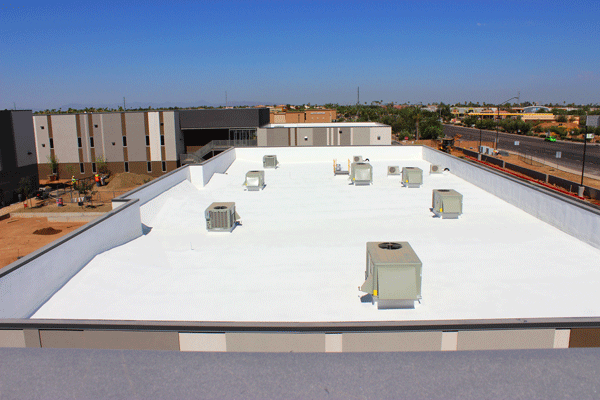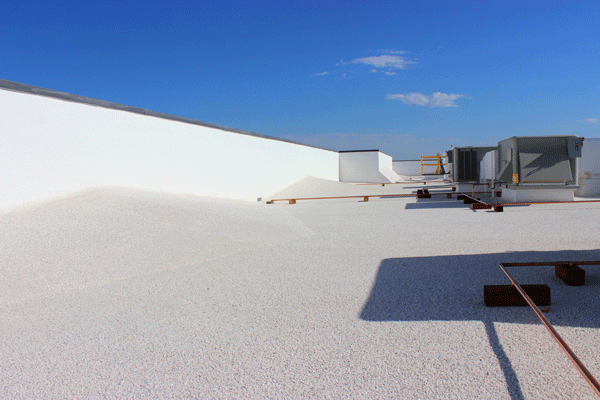While Arizona may be known for its intense sun and scorching temperatures, everything from monsoon rains to gale-force winds can endanger a project at any point from the early application stages to years into a coating’s maturity.
Arizona Foam & Spray, an award-winning roofing contracting company with 45 years of experience in the state, was chosen for a four building, new construction project for Great Hearts Academies, a network of 19 public charter schools in the Phoenix metropolitan area. They’re no stranger to on-the-job challenges.
The three classroom and administrative buildings and single gymnasium roofs combined to make 61,000 square feet (5,667.1 m²) of roof surface to be covered with coated spray polyurethane foam (SPF). The product chosen, Quik-Shield 2020, provided ease of application, durability, energy savings, and longevity that both the client and general contractor agreed would be an ideal solution.
“The biggest thing in Arizona is different needs weather-wise due to the continuous sunlight and being able to stand up to the elements,” explained Jessica Grayek, marketing manager for SWD Urethane. She worked closely with Tony Mackelprang, project manager for Arizona Foam & Spray. “The cementitious coatings added an additional layer of protection, and the longevity of solar reflectants on the buildings is definitely beneficial for a school without a ton of extra income. After all, leaks affect education, not just the bottom line,” Grayek said. The Great Hearts school system aims to provide prep school quality education while maintaining a tuition-free public school setting, so durability and reliability were key.
Materials and Methods
The 30-day project began with newly constructed materials on the administrative building and classrooms (plywood decks) and the gym (metal deck). The walls on all four buildings were concrete masonry. Following two days of prep, the crew took 10 days to apply 26,558 pounds (12.1 metric tons) of spray foam roofing material to all four roofs.
Once the foam was applied, it took nine days to coat the roofs with 1,943 gallons (7,355.1 L) of basecoat and another nine days to apply the cementitious topcoat. The “cool roof” resulting from the Quik-Shield 2020 system created a solar reflectance of up to 82 percent, thus reducing energy costs up to 40 percent along with adding fire retardance, mildew protection, and, as cited by the California Energy Council, a possible two to three year payback for installing a cool roof.
According to Mackelprang, “The key is making certain the right individual applies the product…following the precise specifications down to the application process, since it’s a three-dimensional system rather than a rolled sheet.” The Quik-Shield comes out of the gun as a heavy viscous liquid and within 30 to 90 seconds, it expands to the prescribed thickness. It also fills in cracks rather than leaving behind areas that the crew has to fix by installing flashing. “You need to be skilled and knowledgeable,” he added. “And if you get them all right, the roof should last 25 to 30 years with minimal maintenance.”
The gym, having a different substrate, underwent a different coating process. The crew applied a neoprene-based primer by roller to the metal fasteners to increase adhesion. A 1.5-inch (3.8 cm) layer of Quik-Shield 125 2.5 lb (1.1 kg) roofing SPF sealed the entire system. The team covered all crickets with foam on the gym roof. That helped to divert water and promote proper drainage on the roof. The gym also had 15 large solar tube skylights that needed to be carefully considered to ensure the foam was installed to specifications. The SPF there was used to create a leak-free and air-impermeable seal around the existing skylights.

The three other buildings all received approximately 1 inch (2.5 cm) of the Quik-Shield roofing foam, which was applied directly to the wood deck. According to Grayek, “the applicators monitored and adjusted spray patterns to ensure that the foam was uniformly applied as a smooth surface. Creating a smooth and consistent depth of surface was extremely important with roofing because it would allow for even distribution of coating. Maintaining consistent thickness helps keep product costs within budget, as extra foam and coating is not needed to properly complete the project.”
All four buildings had a white, acrylic basecoat. Larger limestone granules were used due to their better adhesion to the wet acrylic coating. Once the coating dried, crews applied Quik-Shield 2020 cementitious roof coating using a screw pump system at the rate of 1/8- to 1/4-inch (3.2 mm–6.4 mm) thick. As Grayek noted, “This provided the school with the ultimate in high traffic coating systems for their foam roof.”
Storm’s Brewing
The project wasn’t without its pitfalls, as a massive monsoon storm nearly ruined weeks of hard work. While normally the roof is one of the first things completed on a project, generally favorable Arizona weather means much of the interior work can be completed prior to the roof; however, a massive storm in the forecast led to fast action. As Grayek explained, “If the roof wasn’t completed in time, the project would have seen serious setbacks, not only in time, but in money.” The team rearranged their schedule and brought two rigs over immediately, and “the crew worked tirelessly and were able to finish the foam application just before the first drops were falling from the sky. Had another roofing material been chosen for this project, there is no way it could have been finished before the storm hit,” she continued. Mackelprang elaborated, “In addition to the benefit of the excellent relationship with the [general] contractor, the ease of foam application helped us spare the interior improvements. If we had been using a built-up system, mineral, TPO [Thermoplastic polyolefin], or single-ply product, we would have been out there with welding machines, kicking rolls, and cutting pieces to fit the roof.”
Other environmental concerns were minimal. While working on site with other trades, the team had to use safety screens to keep the overspray from getting inside and disrupting the other workers. Safety, always at the forefront of any project, was key not only to the success of the project but also the continuing success of the applicator.
Time and Effort
“One of the most hazardous sectors in the construction industry is roofing,” Grayek noted. “Roofing is strenuous and dangerous work, with roofing contractors being at greater risk of slipping or falling, and they are six times more likely to be involved in fatal occupational injuries than the average worker.” The contractor implemented an extensive safety plan to help mitigate risks, including a documenting policy, Standard Operating Procedures (SOP), the use of personal protective equipment (PPE), and weekly safety meetings. “No job is so important, and no service is so urgent, that one cannot take the time to perform the work safely,” she said.
Arizona Foam & Spray works on projects of varying size, including warehouses and commercial and residential flat roofs. Roofs have a need for an aesthetic touch and that’s exactly what this crew gave to Great Hearts Academies.
